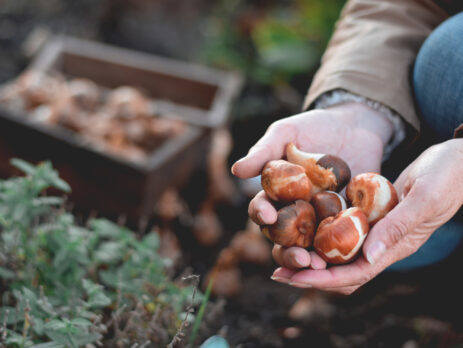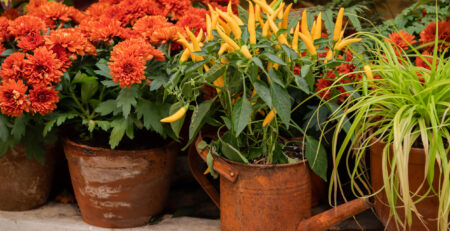🌷 Fall Bulb Planting Guide: Tulips, Daffodils & Crocus
Step-by-step on how and when to plant bulbs now for vibrant spring color
Bring Spring to Life—Starting This Fall
As the air turns crisp and leaves start to fall, it’s time to think ahead to next spring’s burst of color. Planting bulbs like tulips, daffodils, and crocus in fall ensures a beautiful garden come April and May. At Nunan’s Florist & Garden Center in Georgetown, we have everything you need—from premium bulbs and soil to expert advice—to make your spring garden bloom with color and life.
🌼 Why Plant Bulbs in Fall?
Bulbs need a period of cold dormancy to develop roots and prepare for spring growth. Fall’s cool soil and moderate moisture provide the perfect conditions for root establishment before winter. By planting now, you’re setting the stage for a spectacular show of early color when the snow melts away.
🪴 Step-by-Step: How to Plant Fall Bulbs
1. Choose Your Bulbs Wisely
Look for firm, healthy bulbs free of mold or soft spots. At Nunan’s, we carry top-quality varieties, including Proven Winners bulbs and other trusted selections that thrive in Zone 6a.
2. Pick the Right Spot
Select a sunny location with well-draining soil. Most bulbs need at least six hours of sunlight daily to bloom their best.
3. Prepare the Soil
Loosen the soil about 8–10 inches deep. Mix in Espoma Bulb-tone or Coast of Maine compost to enrich the soil and encourage strong root development.
4. Plant at the Correct Depth
-
Tulips: 6–8 inches deep
-
Daffodils: 6 inches deep
-
Crocus: 3–4 inches deep
Always plant with the pointed end facing up and space bulbs according to their size—about two to three bulb widths apart.
5. Water Thoroughly
After planting, give your bulbs a deep watering to settle the soil and start root growth.
6. Add Mulch
Cover the area with a 2–3 inch layer of mulch to insulate the bulbs and help prevent weeds.
7. Mark Your Spot
Use plant markers or a photo on your phone to remember where you planted—so you don’t accidentally dig them up next spring!
🌸 Pro Tips for a Brilliant Bloom
-
Mix it up: Combine early bloomers like crocus with mid-season daffodils and late tulips for waves of color.
-
Naturalize bulbs: Plant them in clusters or drift patterns for a natural look.
-
Fertilize in spring: Once shoots appear, feed again with Bulb-tone for lasting blooms.
-
Protect from critters: Add wire mesh over the soil or sprinkle repellent granules to deter squirrels and chipmunks.
🌿 A Little Local Gardening Wisdom
There’s something special about planting bulbs on a cool fall day—the promise of color waiting quietly beneath the soil. When you’re out in the garden this week, take a moment to imagine those first tulips and daffodils breaking through the ground next spring. It’s one of the simplest joys of gardening: planting today for the beauty of tomorrow.
And if you happen to stop by Nunan’s, you’ll likely find a friendly face or two eager to share what’s blooming, swap a few gardening stories, and help you pick the perfect mix of bulbs for your yard or containers.
❓ FAQ: Fall Bulb Planting (Tulips, Daffodils & Crocus)
When should I plant bulbs in Zone 6a (Georgetown/North Shore MA)?
Plant when soil temperatures are consistently cool—typically late September through November, before the ground freezes. Aim for soil around 50–55°F so roots can establish before winter.
How deep do I plant each type?
-
Tulips: 6–8″ deep
-
Daffodils: ~6″ deep
-
Crocus: 3–4″ deep
A good rule of thumb is to plant bulbs 2–3 times as deep as their height.
Which way is “up”?
Plant with the pointy end up (roots down). If you can’t tell, lay the bulb on its side—it will correct itself.
How far apart should bulbs be spaced?
Space 2–3 bulb-widths apart. For a natural look, plant in clusters or drifts rather than straight rows.
What soil and amendments work best?
Bulbs thrive in well-draining soil. Mix in Coast of Maine compost and Espoma Bulb-tone for nutrients. Avoid overly wet or compacted soil.
How much sun do bulbs need?
Most spring bulbs prefer full sun (6+ hours) but also perform well under deciduous trees, where light reaches the ground before leaves emerge.
Should I water after planting?
Yes—water thoroughly after planting to settle soil and start root growth. After that, fall rains typically provide enough moisture.
Do I need to dig up bulbs every year?
No—daffodils and crocus naturalize and return reliably each year. Tulips may decline after a few seasons, so replant for consistent color.
🌼 Quick Takeaway
Planting bulbs in fall is one of the easiest ways to guarantee cheerful color next spring. With a little effort now—and the right soil, spacing, and timing—you’ll enjoy waves of tulips, daffodils, and crocus welcoming the season back in full bloom.














